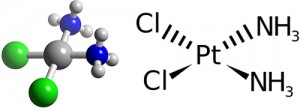 Platinum based anticancer drugs are currently widely used in the treatment of testicular, ovarian, colorectal, and non-small lung cancers.1–3 The flagship drug, cisplatin, has been a prescribed anticancer drug for over 30 years.4 In our lab we use an interdisciplinary approach to synthesize novel platinum compounds. We then use these compounds to study platinum interactions with RNA, proteins and other biomolecules in order to elucidate the cellular effects of platinum binding.
Platinum based anticancer drugs are currently widely used in the treatment of testicular, ovarian, colorectal, and non-small lung cancers.1–3 The flagship drug, cisplatin, has been a prescribed anticancer drug for over 30 years.4 In our lab we use an interdisciplinary approach to synthesize novel platinum compounds. We then use these compounds to study platinum interactions with RNA, proteins and other biomolecules in order to elucidate the cellular effects of platinum binding.
Cisplatin in RNA
We have shown that cisplatin accumulates in cellular RNA to a greater extent than DNA5, and are currently working on determining specific cellular targets of cisplatin. One predicted target is the sarcin-ricin loop, a universally conserved feature of the ribosome We have demonstrated cisplatin accumulation at the sarcin-ricin loop and are investigating the impact of cisplatin on elongation factor binding.
We are also developing cisplatin as a short-range, metal ion-dependent crosslinking reagent for the purpose of RNA structure determination6. Currently, we are utilizing cisplatin crossslinking to study the hepatitis delta virus (HDV) ribozyme, with the goal to better understand the structure of the HDV ribozyme active site and how a magnesium ion involved in the catalytic step is positioned.
Click Chemistry to Identify Platinum (II) Cellular Targets
Understanding the diverse set of roles cellular RNAs play is a challenging goal at the forefront of cellular biology. To shed light on these roles, new methods for RNA detection, labeling, purification, and isolation must be developed. We are optimizing methods for using platinum (II) complexes as small molecule binders to RNA. It is our goal to use these platinum complexes, functionalized with an additional reactive handle, to target cellular RNA without affecting platinum-RNA chemistry. The handles will contain an azide moiety and react orthogonally with an alkyne functionalized substrate, utilizing the azide-alkyne 1,3-dipolar cycloaddition, the prototypical click reaction. Current progress has focused on optimizing click chemistry for DNA systems, as well as investigation of different clickable substrates for different applications (tagging and cell pull-down).
References
(1) Kelland, L. Nature reviews. Cancer 2007, 7, 573–84.
(2) Hannon, M. J. Pure and Applied Chemistry 2007, 79, 2243–2261.
(3) Fricker, S. P. Dalton transactions (Cambridge, England : 2003) 2007, 4903–17.
(4) Wang, X.; Guo, Z. Dalton transactions (Cambridge, England : 2003) 2008, 1521–32.
(5) Hostetter, A.; Osborn, M.; DeRose, V. ACS Chemical Biology 2012, 7(1), 218-225.
(6) Chapman, E.; DeRose, V. JACS 2012, 134(1), 256-262.